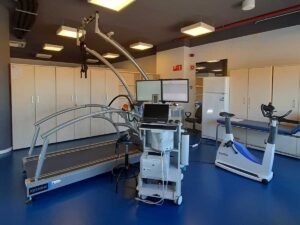Introduction
Elite sport requires high volume and high intensity training. Knowing that, we must take into account the stressful components of training, as well as the repetition of competitions as in team sports, this inevitably affects the performance of athletes.
Therefore, this review will examine the effects of electrostimulation in the recovery of the ability to produce strength and in reducing muscle pain.
Methodological considerations of electrostimulation
Electrostimulation is a key component for many medical and sports applications, and is mainly used for rehabilitation, training and recovery purposes. Different forms of electrostimulation include microcurrent electrostimulation (MENS), high voltage electrical current (HVPC), single phase high voltage electrostimulation (MHVS) or the most commonly used transcutaneous electrostimulation (TENS). Other forms of electrostimulation are also applied and presented under the general term ‘low frequency electrostimulation’ (LFES).
When considering electrostimulation for post-exercise recovery, two main effects are expected. The first, the increase in muscle blood flow that can accelerate the elimination of muscle metabolites. The second effect is the reduction of muscle pain through the analgesic effect of electrostimulation. Depending on the characteristics of electrostimulation, it is believed that it may alter blood flow. Low frequency electrostimulation induces slight muscle contractions responsible for the effect of muscular pumping and improved muscular blood flow. In addition, it has been possible to demonstrate that electrical stimulation could be an effective means to increase the return of venous blood to the heart and, therefore, cardiac output.
| Simulation mode | TENS*1 | LFES*2 |
| Physiological effects | Stimulation of afferent fibers / Increased muscle blood flow | Stimulation of afferent fibers / Increased muscle blood flow |
| Analgesic Effect / Metabolite Elimination | Analgesic Effect / Metabolite Elimination | |
| Influence on recovery | Reduces muscle pain / restoration of neuromuscular properties | Reduces muscle pain / restoration of neuromuscular properties |
| Restore sports performance. | Restore sports performance.. |
*1: TENS (Most commonly used transcutaneous electrostimulation).
*2: LFES (Low frequency electrostimulation).
Electrical stimulation and recovery of neuromuscular parameters.
In the study by Deny and Perrin (1992) positive results were obtained with the use of TENS + Cold regarding the improvement of muscle pain. Also, McLoughlin et al. (2004) showed that 30 min of MHVS produced positive effects on muscle pain. On the other hand, Grunovas et al. (2007) showed that 10 min of LFES gave positive results regarding the capacity of muscular work and the functioning of blood flow. Tessitore et al. (2007) also demonstrated that 20 min of LFES gave positive effects on subjective ratings. Also, Vanderthommen et al. (2007) showed that 25 min of LFES produced positive effects regarding CK activity. Heyman et al. (2009) y Neric et al. (2009) demostraron que 20 min de LFES dió resultados positivos en cuanto a los niveles de lactato en sangre.
Concluding remarks
When used as a recovery modality, electrostimulation showed some positive effects on lactate removal or CK activity, but there is still evidence of restoration of performance indicators, such as muscle strength. The absence of any positive effect could be due to the type of methodology applied, different intensity thresholds should be analyzed to achieve the greatest benefit in terms of recovery.
Bibliography
Babault, Nicolas Cometti, Carole Maffiuletti et al. (2011). Does electrical stimulation enhance post-exercise performance recovery? European Journal of Applied Physiology 111:2501–2507







